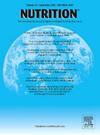Association between adiposity distribution and low-grade systemic inflammation: Tackling multicollinearity
IF 3.2
3区 医学
Q2 NUTRITION & DIETETICS
引用次数: 0
Abstract
Objectives
To examine the association between adiposity distribution and low-grade systemic inflammation, testing how the statistical approach can be used to tackle the multicollinearity between variables of adiposity.
Methods
Cross-sectional analysis of 987 adults (27 years old) from the EPITeen cohort (Porto, Portugal). Adiposity distribution was assessed based on the fat distribution of the participants, measured by whole-body dual-energy X-ray absorptiometry (DXA). Low-grade systemic inflammation was determined based on the serum high-sensitivity C-reactive protein (hsCRP) of the participants. The associations were estimated by linear regression models, stratified by sex, and multicollinearity between variables of adiposity was considered.
Results
The association (standardized β [95%CI]) between total body fat and hsCRP (ln) was 0.332 (0.252, 0.411) in women and 0.256 (0.175, 0.337) in men. Finally, in women, the association (standardized β [95%CI]) with hsCRP (ln) was −0.014 (−0.094, 0.065) for limb fat and 0.019 (−0.061, 0.099) for trunk fat, and, in men it was −0.136 (−0.216, −0.056) for limb fat and 0.130 (0.050, 0.211) for trunk fat.
Conclusions
After a comprehensive study of fat, its overall proinflammatory effect was acknowledged. Trunk fat was more proinflammatory than limb fat, even though the results were only statistically significant in men. Statistical analysis should consider multicollinearity between variables of adiposity, though simpler models could be used to address this problem.
肥胖分布与低度全身性炎症之间的关系:多重共线性处理
方法对葡萄牙波尔图 EPITeen 队列中的 987 名成年人(27 岁)进行横断面分析。通过全身双能 X 射线吸收仪(DXA)测量参与者的脂肪分布,评估脂肪分布情况。根据参与者的血清高敏C反应蛋白(hsCRP)确定低度全身炎症。结果女性总体脂率与 hsCRP(ln)之间的关系(标准化 β [95%CI])为 0.332(0.252,0.411),男性为 0.256(0.175,0.337)。最后,女性四肢脂肪与 hsCRP(ln)的相关性(标准化β[95%CI])为-0.014(-0.094,0.065),躯干脂肪为 0.019(-0.061,0.099),男性为-0.019(-0.061,0.099)。结论经过对脂肪的全面研究,脂肪的整体促炎作用得到了认可。躯干脂肪比四肢脂肪更容易引发炎症,尽管这一结果只对男性有统计学意义。统计分析应考虑脂肪变量之间的多重共线性,尽管可以使用更简单的模型来解决这个问题。
本文章由计算机程序翻译,如有差异,请以英文原文为准。
求助全文
约1分钟内获得全文
求助全文
来源期刊

Nutrition
医学-营养学
CiteScore
7.80
自引率
2.30%
发文量
300
审稿时长
60 days
期刊介绍:
Nutrition has an open access mirror journal Nutrition: X, sharing the same aims and scope, editorial team, submission system and rigorous peer review.
Founded by Michael M. Meguid in the early 1980''s, Nutrition presents advances in nutrition research and science, informs its readers on new and advancing technologies and data in clinical nutrition practice, encourages the application of outcomes research and meta-analyses to problems in patient-related nutrition; and seeks to help clarify and set the research, policy and practice agenda for nutrition science to enhance human well-being in the years ahead.
 求助内容:
求助内容: 应助结果提醒方式:
应助结果提醒方式:


